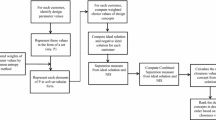Abstract
Although many conceptual design methods have been proposed, there is still ample room for improvement. First, most conceptual design methods do not relate concepts generation by a combination of basic features to the feasibility of the concepts. Second, those methods may have ignored customer preferences in modeling concept selection. To overcome these shortcomings, a quality-engineering-based conceptual design approach is proposed in this paper by integrating the use of quality function deployment (QFD), morphological matrix analysis (MMA), multi-attribute decision-making techniques (MADM), and possibilistic optimization models (POMs). A possibility distribution function (PDF) is applied to account for the uncertainties of technology development cost in the early design stages, and a mathematical framework is established by incorporating the customer-perceived relative importance into a possibilistic optimization model for design concept selection, which plays a central role in the proposed methodology. Contrary to deterministic optimization models (DOMs), the proposed possibilistic optimization can produce results that are more informative and more reliable to the designers.
Similar content being viewed by others
References
Qiu SL, Fok SC, Chen CH, Xu S (2002) Conceptual design using evolution strategy. Int J Adv Manuf Technol 20(9):683–691
Seo K-K, Park J-H, Jang D-S, Wallace D (2002) Approximate estimation of the product life cycle cost using artificial neural networks in conceptual design. Int J Adv Manuf Technol 19(6):461–471
Pugh S (1991) Total design: integrated methods for successful product engineering, 2nd edn. Addison-Wesley, New York
Ulrich KT, Eppinger SD (2000) Product design and development, 2nd edn. McGraw-Hill, Boston, Massachusetts
Chen Y, Tang J, Fung RYK, Ren Z (2004) Fuzzy regression-based mathematical programming model for quality function deployment. Int J Prod Res 42(5):1009–1027
Armacost RL, Componation PJ, Mullens MA, Swart WW (1994) An AHP framework for prioritizing customer requirements in QFD: an industrialized housing application. IIE Trans 26(4):72–79
Fung RYK, Law DST, Ip WH (1999) Design targets determination for inter-dependent product attributes in QFD using fuzzy inference. Integr Manuf Syst 10(6):376–384
Sopadang A, Cho B-R, Leonard MS (2003) Development of the hybrid weight assessment system for multiple quality attributes. Qual Eng 15(1):75–89
Akao Y (1990) Quality function deployment: integrating customer requirements into product design (translated by Glenn Mazur). Productivity Press, Cambridge, Massachusetts
Hauser JR, Clausing D (1988) The house of quality. Harvard Bus Rev 66(3):63–73
Chen CH, Khoo LP, Yan W (2002) Web-enabled customer-oriented product concept formation via laddering technique and Kohonen association. Concurr Eng Res Appl 10(4):299–310
Wasserman G (1993) On how to prioritize design requirements during the QFD planning process. IIE Trans 25(3):59–65
Norris KW (1963) The morphological approach to engineering design. In: Jones JC, Thornley D (eds) Conference on design methods. Pergamon Press, Oxford
Huang GQ, Mak KL (1999) Web-based morphological charts for concept design in collaborative product development. J Intell Manuf 10(3–4):267–278
Hwang CL, Yoon K (1981) Multiple attribute decision making—methods and applications: a state-of-the-art survey. Springer, Berlin Heidelberg New York
Reeve JM, Sullivan WG (1990) A synthesis of methods for evaluating interrelated investment projects. In: Liberatore MJ (ed) Selection and evaluation of advanced manufacturing technologies. Springer, Berlin Heidelberg New York
Fung RYK, Tang J, Tu Y, Wang D (2002) Product design resources optimization using a non-linear fuzzy quality function deployment model. Int J Prod Res 40(3):585–599
Tang J, Fung RYK, Xu B, Wang D (2002) A new approach to quality function deployment planning with financial consideration. Comput Oper Res 29(11):1447–1463
Author information
Authors and Affiliations
Corresponding author
Rights and permissions
About this article
Cite this article
Fung, R.Y.K., Chen, Y. & Tang, J. A quality-engineering-based approach for conceptual product design. Int J Adv Manuf Technol 32, 1064–1073 (2007). https://doi.org/10.1007/s00170-006-0434-5
Received:
Accepted:
Published:
Issue Date:
DOI: https://doi.org/10.1007/s00170-006-0434-5



